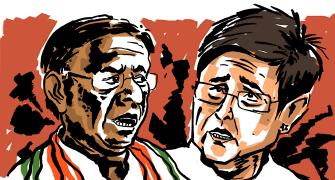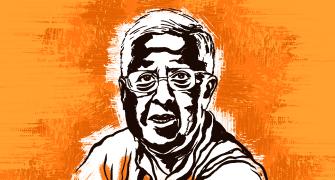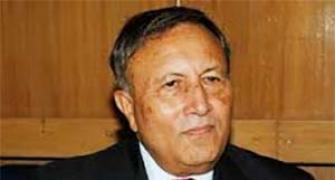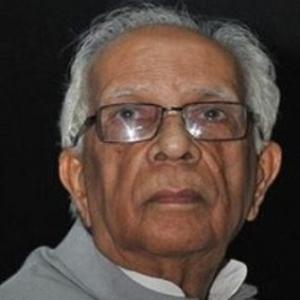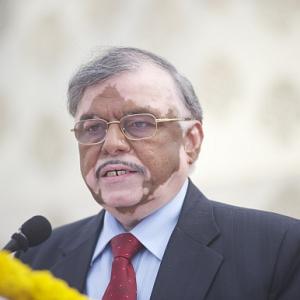'Both the governor and the President enjoy an enormous array of 'grey' powers.'
'All parties criticise these when in the Opposition. But why does no government dismantle them when these parties come to power?' asks Aditi Phadnis.
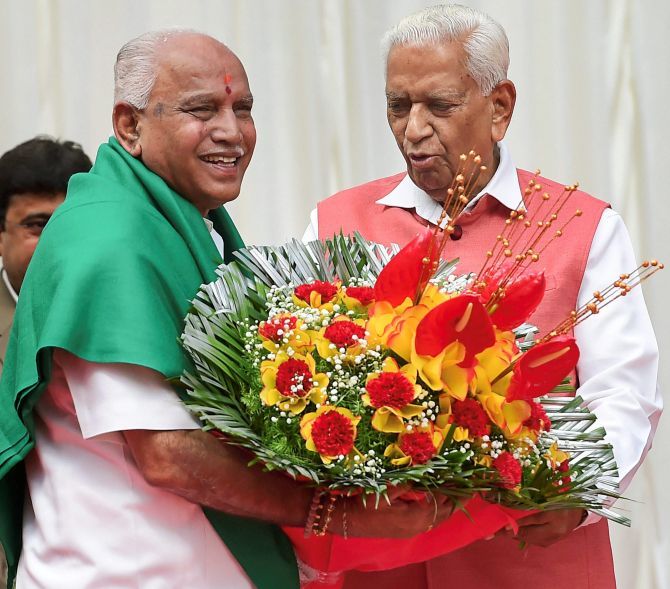
Yeddyurappa resigned two days later before a vote of confidence in the state assembly, compelling Vala, right, to invite the Janata Dal-Secular-Congress alliance to form a government. Photograph: Shailendra Bhojak/PTI Photo
The use -- and misuse -- of the office of the governor was cause célèbre, especially in Opposition politics in the decade of the 1980s.
For reporters, it was a wonderful time, especially when the then Andhra Pradesh governor, Ram Lal, dismissed N T Rama Rao's elected, majority, government and installed Nadendla Bhaskara Rao in office with then prime minister Indira Gandhi's clear and unambiguous approval.
Worse, the drama occurred when NTR was in the US for a coronary bypass, and images of him returning from his travels and sleeping, exhausted, on a bench at Begumpet airport caught the public imagination like nothing else.
Then there were the antics of A P Sharma, another Congress governor in Left Front-ruled West Bengal.
As chancellor of Calcutta University, he appointed Santosh Bhattacharya as vice-chancellor leading to protests that then chief minister Jyoti Basu himself led.
Sharma's 10-month stint (1983-1984) saw frenzied public protests as cries of 'A P Sharma gaddi chhoro, Bangal chhoro (A P Sharma leave your chair, leave Bengal)' rent the air.
Soon after, in 1989-1990, the appointment of T V Rajeshwar, a former Intelligence Bureau chief, as Bengal governor by Rajiv Gandhi did nothing to dispel suspicion and he was replaced when V P Singh came to power with the CPI-M's support.
When the National Democratic Alliance government came to power in 2014, cooperative federalism became the buzzword especially after the Finance Commission award.
But the governor's role continued to be a bugbear. Problems started from the word go.
Jyoti Prasad Rajkhowa, an IAS officer from Assam, was appointed governor of Arunachal Pradesh.
In 2016, Rajkhowa was asked to step down as governor by Home Minister Rajnath Singh and when he refused, he had to be dismissed by then President Pranab Mukherjee after the Supreme Court criticised in trenchant terms the governor's action in deciding to move the Arunachal Pradesh assembly session from January 14, 2016, to December 16, 2015, to conduct the floor test of the then Nabam Tuki government, prior to its sacking.
A government headed by Kalikho Pul was installed instead, with the BJP's support.
The Congress went to court. In July 2016, the Supreme Court directed restoration of the status quo ante as it existed on December 15, 2015, bringing back the Congress government in Arunachal Pradesh.
The court said the governor 'cannot interfere in the activities of the assembly.'
It also quashed the President's Rule imposed in the state and all the decisions taken by Rajkhowa, leading to imposition and formation of a new government led by a breakaway faction of the Congress.
Kalikho Pul committed suicide and his suicide note -- a dying declaration still considered of evidentiary value -- named the sons of several high ranking persons who approached him with 'help' in restoring him to power for a consideration.
The BJP claimed it had nothing to do with the Rajkhowa operation. That's not what Rajkhowa said.
It didn't end with that.
Puducherry Lieutenant Governor Kiran Bedi completed two years in office on May 28. That was the day she had said she was going to quit, in an open letter to citizens of Puducherry (she also said she'd informed her 'seniors', whoever they are).
The Union territory has a Congress government and friction between the lieutenant governor and Chief Minister V Narayanasamy is no secret.
Bedi made a WhatsApp group to monitor the punctuality of officials. Narayanasamy said government officials could not become part of groups on social media and asked them not to take orders from the lieutenant governor without informing him first.
He also asked officials not to meet the lieutenant governor without cabinet permission.
Bedi ignored all this and administered the oath of office to three nominated BJP legislators -- a job which is usually done by the speaker of the legislative assembly though the lieutenant governor has the power to do. But Narayanasamy saw red.
The tension between the Delhi government and successive lieutenant governors is no secret.
In Bengal relations between Chief Minister Mamata Banerjee and Governor Keshari Nath Tripathi are extremely strained since 2017.
'The Raj Bhavan is not a department of the state government and it is open to every citizen to approach him for redressal of his or her grievances,' Tripathi observed.
'It is wrong to say that Raj Bhavan has become the office of the BJP or the RSS' Tripathi declared after Banerjee charged him with interfering in her handling of law and order.
The trigger was communal violence in Baduria and Banerjee said the governor called her and castigated her for not bringing the violence under control.
Both the governor and the President enjoy an enormous array of 'grey' powers.
All parties criticise these when in the Opposition. But why does no government dismantle them when these parties come to power?


